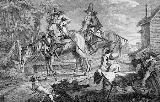
List of works by William Hogarth
Encyclopedia
List of works by William Hogarth
by publication date (if known). As a printmaker Hogarth often employed other engravers to produce his work and frequently revised his works between one print run and the next, so it is often difficult to accurately differentiate between works by (or for) Hogarth and those in the style of or "after". Some of the less likely, possible, doubtful works and those formerly identified as Hogarth's works are listed at the end. Numbers in square brackets refer to the catalogue numbers in Ronald Paulson's
third edition of Hogarth's Graphic Works (those with asterisks are classified as "After Hogarth" by Paulson).

Southwark Fair (1733)—issued with A Rake's Progress [131]
The Edwards Family (1733-34)
The Distrest Poet
(c.1733-36) painting (1737) print—issued with Scholars at a Lecture and The Company of Undertakers (1740) print—issued together with The Enraged Musician [145]
The Pool of Bethesda (c.1735)
Satan, Sin and Death (1735-40)
Self Portrait (c.1735-40)
Thomas Pellett, M.D. (c. 1735-39)
The Sleeping Congregation painting (1728) print (1736) [140]
Scholars at a Lecture (1736) [143]
The Company of Undertakers (1736) [144]
Three Ladies in a Grand Interior/ The Broken Fan / possibly Catherine Darnley, Duchess of Buckingham with Two Ladies (c.1736)
Woman Swearing A Child To A Grave Citizen—print engraved by Joseph Symons c. 1736
The Good Samaritan (1737)
Four Times of the Day
paintings (1736) prints (1738)—four comic views of life in London [146–149]
Noon
Evening
Night
Strolling Actresses Dressing in a Barn
(1738)—issued with Four Times of the Day, the original painting was destroyed in a fire in 1874 [150]
Benjamin Hoadly, Bishop of Winchester (1738)—a later portrait was produced in 1741
The Strode Family (c.1738-42)
The Western Family (1738)
George Arnold (c.1738-1740)
Francis Arnold (c.1738-1740)
James Quin, Actor (1739)
Charity in the Cellar (c.1739)
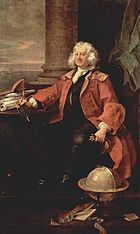




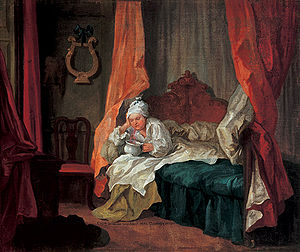
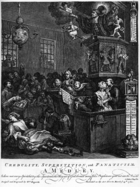
William Hogarth
William Hogarth was an English painter, printmaker, pictorial satirist, social critic and editorial cartoonist who has been credited with pioneering western sequential art. His work ranged from realistic portraiture to comic strip-like series of pictures called "modern moral subjects"...
by publication date (if known). As a printmaker Hogarth often employed other engravers to produce his work and frequently revised his works between one print run and the next, so it is often difficult to accurately differentiate between works by (or for) Hogarth and those in the style of or "after". Some of the less likely, possible, doubtful works and those formerly identified as Hogarth's works are listed at the end. Numbers in square brackets refer to the catalogue numbers in Ronald Paulson's
Ronald Paulson
Ronald Paulson , is an American professor of English, a specialist in English 18th-century art and culture, and English artist William Hogarth.-Education:...
third edition of Hogarth's Graphic Works (those with asterisks are classified as "After Hogarth" by Paulson).
1720s
- Tatton Coat of Arms (early) [1]
- Benefit ticket for Spiller (1720?) [2]
- Shop card (1720)—advertising Hogarth's own engraving shop [3]
- Shop card for Hardy (early) [4]
- Funeral ticket (c.1721-36) [22]
- Shop card for Ellis Gamble (c.1723 or 1728) [23]
- Impression from a tankard belonging to the Clare Market Artists Club (early) [25]
- Kendal Arms (1723 or later) [26 (27)]
- Self-portrait with two figures and two cupids (1720)
- Emblematical Print on the South Sea SchemeEmblematical Print on the South Sea SchemeEmblematical Print on the South Sea Scheme is an early print by William Hogarth, created in 1721 and widely published from 1724. It caricatures the financial speculation, corruption and credulity that caused the South Sea Bubble in England in 1720–1.-Background:The South Sea Company was a British...
/ The South Sea Scheme (c.1721) [43] - Fifteen illustrations for Aubrey De La Montraye's Travels (1723) [28–42]
- Seven small prints for ApuleiusApuleiusApuleius was a Latin prose writer. He was a Berber, from Madaurus . He studied Platonist philosophy in Athens; travelled to Italy, Asia Minor and Egypt; and was an initiate in several cults or mysteries. The most famous incident in his life was when he was accused of using magic to gain the...
's Golden Ass (1724) - The Lottery (1724) [53]
- The Mystery of Masonry brought to Light by ye Gormogons (1724) [55]
- The Bad Taste of the Town / The Taste of the Town / Masquerades and Operas (1724) - Hogarth's first attempt to publish his own satirical print, an attempt frustrated by the printmakers' monopoly [44]
- Seven illustrations for Gildon's New Metamorphosis (1723) [45–51]
- A Just View of the British StageA Just View of the British StageA Just View of the British Stage or Three Heads are Better than One is a 1724 engraving by English artist William Hogarth. It is a satirical view of the management of British plays and mocks the subjects as degenerate...
(1724) [57] - Royalty, Episcopacy, and Law / Some of the Principal Inhabitants of the Moon (c.1724-25) [56]
- Five illustrations for La Calprenede's Cassandra (1725) [58–62]
- A Burlesque on Kent's Altarpiece at St. Clement Danes (1725) [63]
- Two illustrations for Milton's Paradise Lost (1725) [64–65]
- Fourteen illustrations for Beaver's Roman Military Punishments (1725) [66–79]
- Sign for a Paviour (c.1725)
- The Carpenter's Yard (c.1725)
- The Doctor's Visit (c.1725)
- Seventeen Small Illustrations for Samuel Butler's HudibrasHudibrasHudibras is an English mock heroic narrative poem from the 17th century written by Samuel Butler.-Purpose:The work is a satirical polemic upon Roundheads, Puritans, Presbyterians and many of the other factions involved in the English Civil War...
(1726)—engraved in 1721 they were published alongside the twelve large illustration in the 1726 edition [5–21]

- Twelve illustrations for Samuel Butler's HudibrasHudibrasHudibras is an English mock heroic narrative poem from the 17th century written by Samuel Butler.-Purpose:The work is a satirical polemic upon Roundheads, Puritans, Presbyterians and many of the other factions involved in the English Civil War...
(1726) [82–93] - Sancho's Feast (possibly before the illustrations of Don Quixote, probably before 1733) [100]
- Six illustrations for Cervante's Don Quixote (c.1726) [94–99]
- Frontispiece for Terrae-Filius (1726) [101]
- Twenty-six figures (on two plates) for Blackwell's Compendium of Military Discipline (1726) [102,103]
- Letterhead for Blundell's SchoolBlundell's SchoolBlundell's School is a co-educational day and boarding independent school located in the town of Tiverton in the county of Devon, England. The school was founded in 1604 by the will of Peter Blundell, one of the richest men in England at the time, and relocated to its present location on the...
, Tiverton (1726) [104] - Cunicularii / The Wise Men of Godliman in Consultation (1726) - a satire on the "learned" doctors taken in by Mary Toft, a subject revisited in Credulity, Superstition, and Fanaticism [106]
- The Punishment Inflicted on Lemuel Gulliver (1726) [107]
- A Garret Scene (c.1726)
- Shop card for Mrs. Holt's Italian Warehouse (unknown) [106]
- His Royal Highness George, Prince of Wales (before 1727) [54]
- Masquerade Ticket (1727) [108]
- Frontispiece to Leveridge's Collection of Songs [110]
- Frontispiece to Cooke's Hesiod (1727) [111]
- The Carpenter's Yard (1727?)
- Music Introduced To Apollo By Minerva (1727?) [109]
- Benefit ticket for Milward (1728) [112]
- Henry the Eighth and Anne Boleyn (1728–29) [113]
- The Great Seal of England (1728–29) [114]
- Two illustrations for Theobald's Perseus and Andromeda (1729) [115,116]
1730s
- Shop card for Mary and Ann Hogarth (1730) [117]
- Bookplate for George Lambert (1730?) [118]
- Paulet book plate (unknown) [119]
- The Beggar's Opera (various versions between 1728 and 1731, all showing a scene from Act III; Scene xi)
- The Beggar's Opera I (c.1728)
- The Beggar's Opera II (1728)
- The Beggar's Opera III
- The Beggar's Opera IV (c.1728)
- The Beggar's Opera V
- The Beggar's Opera VI (1729–31)
- An Assembly at Wanstead House (1728-31)
- The Denunciation (1729)
- Woodes Rogers and his Family (1729)
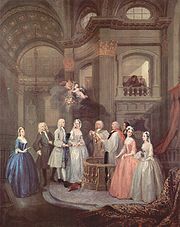
- The Wedding of Stephen Bechingham and Mary Cox (1729–30)
- Bambridge on Trial for Murder by a Committee of the House of Commons / The Committee of the House of Commons (1729)
- The Christening / Orator Henley Christening A Child (c.1729)
- Debates on Palmistry (c.1729)
- Falstaff Examining His Recruits (1730)—the oldest known painting of a scene from Shakespeare
- The Wollaston Family (1730)
- The House of Cards (1730)—two scenes of children playing sometimes paired.
- The House of Cards
- A Children's Party
- The Ashley and Popple Family (1730)
- Boys Peeping at Nature (1730)—subscription ticket for A Harlot's Progress, modified and reused as subscription ticket for Paul Before Felix and Moses Brought Before Pharaoh's Daughter in 1751 [120]
- The Jones Family (c.1730)
- An Auction of Pictures (c.1730)
- A Fishing Party / A Fair Angler (c.1730)
- Conversation Piece (Portrait of Sir Andrew Fountaine with Other Men and Women) / The Fountaine Family (c.1730-1735)
- A Scene from "The Tempest" (c.1730-1735)
- Before and After—a comic view of the differing attitudes of men and women to love making. Various versions:
- Before and After oil-on-canvas, exterior scene (1730-31)
- Before and After oil-on-canvas, interior scene (1730-31)
- Before and After engraving, interior scene (1736) [141,142]
- Ashley Cowper with his Wife and Daughter (1731)
- The Theft of a Watch (1731)
- The Family of George II The Royal Family (1731–32)
- The Royal Family II (1732–33)

- A Harlot's ProgressA Harlot's ProgressA Harlot's Progress is a series of six paintings and engravings by William Hogarth. The series shows the story of a young woman, Mary Hackabout, who arrives in London from the country and becomes a prostitute...
(1732)—six pictures showing the path of a pretty country girl lured into a life of prostitution [121–126]- Plate 1 (Ensnared by a Procuress)
- Plate 2 (Quarrels with her Jew Protector)
- Plate 3 (Apprehended by a Magistrate)
- Plate 4 (Scene in Bridewell)
- Plate 5 (Expires while the Doctors are Disputing)
- Plate 6 (The Funeral)
- A Chorus of Singers / The Chorus / Rehearsal of the Oratorio of Judith—subscription ticket for Midnight Modern Conversation (1732) [127]
- A Midnight Modern Conversation painting and print (1732) [128]
- The Cholmondeley Family (1732)
- A Performance of "The Indian Emperor or The Conquest of Mexico by the Spaniards" (1732-1735)
- Sarah Malcolm / Sarah Malcolm in Prison (1732) [129]
- H.R.H. William Augustus, Duke of Cumberland (c.1732)
- The Marriage Contract (c.1732)—a study for A Rake's Progress this was likely to have been intended as the second scene
- Gerard Anne Edwards in His Cradle (1733)
- A Laughing Audience / A Pleased Audience (1733)—subscription ticket for A Rake's Progress [130]
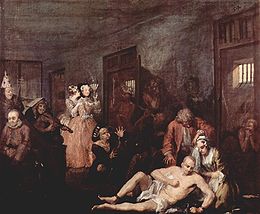
- A Rake's ProgressA Rake's ProgressA Rake's Progress is a series of eight paintings by 18th century English artist William Hogarth. The canvases were produced in 1732–33 then engraved and published in print form in 1735...
paintings (1732-33) prints(1735)—a series of eight scenes depicting the dissolute life of a young heir and his descent into poverty and madness [132–139] - The Levee
- The Orgy
- The Arrest
- The Marriage
- The Gaming House
- The Prison
- The Madhouse
The Distrest Poet
The Distrest Poet is an oil painting produced sometime around 1736 by the British artist William Hogarth. Reproduced as an etching and engraving, it was published in 1741 from a third state plate produced in 1740. The scene was probably inspired by Alexander Pope's satirical poem The Dunciad...
(c.1733-36) painting (1737) print—issued with Scholars at a Lecture and The Company of Undertakers (1740) print—issued together with The Enraged Musician [145]
Four Times of the Day
Four Times of the Day is a series of four paintings by English artist William Hogarth. Completed in 1736, they were reproduced as a series of four engravings published in 1738. They are humorous depictions of life in the streets of London, the vagaries of fashion, and the interactions between the...
paintings (1736) prints (1738)—four comic views of life in London [146–149]
Strolling Actresses Dressing in a Barn
Strolling Actresses Dressing in a Barn is a painting from 1738 by William Hogarth reproduced as an engraving and issued with Four Times of the Day as a five print set in the same year. It depicts a company of actresses preparing for their final performance before the troupe is disbanded as a result...
(1738)—issued with Four Times of the Day, the original painting was destroyed in a fire in 1874 [150]
1740s

- Hymen and Cupid (1740) [151]
- Captain Thomas Coram (1740)
- William Jones (1740)
- Lord Grey and Lady Mary West as Children (1740)
- Ticket for Tiverton (Blundell'sBlundell's SchoolBlundell's School is a co-educational day and boarding independent school located in the town of Tiverton in the county of Devon, England. The school was founded in 1604 by the will of Peter Blundell, one of the richest men in England at the time, and relocated to its present location on the...
) School Feast (1740) - Head of a Lady, called Lady Pembroke (c.1740)
- The Hervey Conversation Piece / Lord Hervey and His Friends (c.1740)
- The Shrimp GirlThe Shrimp GirlThe Shrimp Girl is a painting by the English artist William Hogarth. It was painted around 1740–45, and is held by the National Gallery, London....
(c.1740-45)—unfinished - Lavinia Fenton, Duchess of Bolton (c. 1740-50)
- Mrs Salter (1741 or 1744)
- Benjamin Hoadly, Bishop of Winchester (1741)
- William Cavendish, Marquess of Hartington, Later 4th Duke of Devonshire (1741)
- The Enraged MusicianThe Enraged MusicianThe Enraged Musician is a 1741 etching and engraving by English artist William Hogarth which depicts a comic scene of a violinist driven to distraction by the cacophony outside his window...
(1741) [152] - The Charmers of the Age (1741) [153]
- Taste in High LifeTaste in High LifeTaste in High Life is an oil-on-canvas painting from around 1742, by William Hogarth. The version seen on the right was engraved by Samuel Phillips in 1798, under commission from John Boydell for a posthumous edition of Hogarth's works, but Phillips's final, third state was not published until...
(c.1742) - Martin Folkes (1742) [154]
- The Graham Children (1742)
- The Mackinen Children (1742-43)
- Miss Mary Edwards (1742)
- Characters and CaricaturasCharacters and CaricaturasCharacters and Caricaturas is a engraving by English artist William Hogarth, that he produced as the subscription ticket for his 1743 series of prints, Marriage à-la-mode, and which was eventually issued as a print in its own right...
(1743)—subscription ticket for Marriage à-la-mode [156]



- Marriage à-la-mode paintings (1735) prints (1743)—six satirical pictures commenting on fashionable society. Commonly considered Hogarth's masterwork [158–163]
- The Marriage Settlement / The Marriage Contract
- The Tête à Tête / Shortly After the Marriage
- The Inspection / Visit to the Quack Doctor
- The Toilette / The Duchess' Morning Levee
- The Bagnio / The Death of the Earl
- The Lady's Death / The Suicide of the Duchess
- The Discovery (c.1743?) [155]
- The Battle of the Pictures (1744)—subscription ticket for an auction of Hogarth's works [157]
- Thomas Herring, Archbishop of Canterbury (1744-47)
- John Huggins (before 1745)
- Captain Lord Graham in his Cabin (c.1745)
- Mary Blackwood, Mrs Desaguliers (c.1745)
- The Happy Marriage—Hogarth planned a series with this title but never finished it, and it is uncertain as to which pictures were intended for the series but the two below are most likely. A plate of The Stay-Maker is claimed to have been produced
- The Stay-Maker / The Happy Marriage V: The Fitting of the Ball Gown (c.1745)
- The Dance / The Happy Marriage VI: The Country Dance (c.1745)
- Gulielmus Hogarth / Self-Portrait with Pug-Dog / The Painter and his Pug painting (1745) print (1748) [181]
- Mask and Palette (1745)—subscription ticket for David Garrick in the Character of Richard III [164]
- David Garrick in the Character of Richard III painting (1745) print (1746) [165]
- Simon Lord Lovat (1746) [166]
- The Stage-Coach, Or The Country Inn Yard (1747) [167]
- Industry and IdlenessIndustry and IdlenessIndustry and Idleness is the title of a series of 12 plot-linked engravings created by William Hogarth in 1747, intending to illustrate to working children the possible rewards of hard work and diligent application and the sure disasters attending a lack of both...
(1747)—a series of twelve pictures showing the divergent courses of the lives of two apprentices. The industrious apprentice becomes Lord Mayor of London while the idle apprentice ends his life at the gallows. [168–179]- The Fellow 'Prentices at their Looms
- The Industrious 'Prentice performing the Duty of a Christian
- The Idle 'Prentice at Play in the Church Yard, during Divine Service
- The Industrious 'Prentice a Favourite, and entrusted by his Master
- The Idle 'Prentice turn'd away, and sent to Sea
- The Industrious 'Prentice out of his Time, & Married to his Master's Daughter
- The Idle 'Prentice return'd from Sea, & in a Garret with common Prostitute
- The Industrious 'Prentice grown rich, & Sheriff of London
- The Idle 'Prentice betrayed (by his Whore), & taken in a Night-Cellar with his Accomplice
- The Industrious 'Prentice Alderman of London, the Idle one brought before him & Impreach'd by his Accomplice
- The Idle 'Prentice Executed at Tyburn
- The Industrious 'Prentice Lord-Mayor of London
- The Gate of CalaisThe Gate of CalaisThe Gate of Calais or O, the Roast Beef of Old England is a 1748 painting by William Hogarth, reproduced as a print from an engraving the next year. Hogarth produced the painting directly after his return from France, where he had been arrested as a spy while sketching in Calais...
/ O the Roast Beef of Old England painting (1748) print (1749)—a comic view of the French inspired by Hogarth's arrest as a spy in Calais [180] - Portrait of George Osborne, later John Ranby Jnr (c.1748-50)
- Portrait of Hannah, Daughter of John Ranby Snr (c.1748-50)
1750s
- View of Ranby's House (1750s?) [182]
- View of David Loudon's Bun House at Chelsey (1750)
- Designs for the tombstone of George Taylor (c.1750)
- George Taylor Triumphing over Death
- Death Giving George Taylor a Cross-Buttock
- A Stand of Arms, Musical Instruments, etc. (1750)—subscription ticket for The March of the Guards to Finchley [183]
- The March of the Guards to FinchleyThe March of the Guards to FinchleyThe March of the Guards to Finchley, also known as The March to Finchley or The March of the Guards, is a 1750 oil-on-canvas painting by English artist William Hogarth, owned by the Thomas Coram Foundation for Children since 1750 and now housed at the Foundling Museum...
/ The March to Finchley (1750) [184] - Hogarth's ServantsHogarth's ServantsHeads of Six of Hogarth's Servants is an oil-on-canvas painting by William Hogarth from c.1750-5. Measuring high and wide, it depicts the heads of six of his servants. It is held by in the Tate Gallery in London....
/ Heads of Six of Hogarth's Servants (c. 1750-5) - Beer Street and Gin LaneBeer Street and Gin LaneBeer Street and Gin Lane are two prints issued in 1751 by English artist William Hogarth in support of what would become the Gin Act. Designed to be viewed alongside each other, they depict the evils of the consumption of gin as a contrast to the merits of drinking beer...
(1751)—a stark illustration of the relative merits of beer and gin [185,186] - The Four Stages of CrueltyThe Four Stages of CrueltyThe Four Stages of Cruelty is a series of four printed engravings published by English artist William Hogarth in 1751. Each print depicts a different stage in the life of the fictional Tom Nero....
(1751)—four prints issued in response to the barbaric practices Hogarth witnessed in the streets of London [187–190]


-
- The First Stage of Cruelty
- The Second Stage of Cruelty
- The Third Stage of Cruelty
- The Forth Stage of Cruelty
- Paul Before Felix Burlesqued (1751)—subscription ticket for Paul Before Felix and Moses Brought Before Pharaoh's Daughter [191]
- Paul Before Felix (1752) [192]
- Moses Brought Before Pharaoh's Daughter (1752) [193]
- Columbus Breaking the EggColumbus Breaking the EggColumbus Breaking the Egg is a 1752 engraving by English artist William Hogarth. Issued as the subscription ticket for his treatise on art, The Analysis of Beauty, it depicts an apocryphal tale concerning Christopher Columbus's response to detractors of his discovery of the New World...
(1752)—subscription ticket of The Analysis of Beauty [194] - The Analysis of BeautyThe Analysis of BeautyThe Analysis of Beauty is a book written by William Hogarth and published in 1753, which describes Hogarth's theories of visual beauty and grace in a manner accessible to the common man of his day....
—Book (1753) - Satire on False PerspectiveSatire on False PerspectiveSatire on False Perspective is the title of an engraving produced by William Hogarth in 1754 for his friend John Joshua Kirby's pamphlet on linear perspective.The intent of the work is clearly given by the subtitle:-Summary:...
(1754) [232*] - Crowns, Mitres and Maces—subscription ticket for Four Prints of an Election paintings (1754) prints (1755) [197]
- Four Prints of an Election / Humours of an Election / An Election Series (1755)—a wry look at election practices [198–201]
- An Election Entertainment
- Canvassing for Votes
- The Polling
- Chairing the Member
- Francis Matthew Schutz in his Bed (c.1755-60)—the original which showed Schutz vomiting into a bowl was eventually overpainted to show him reading a book
- John Pine (c.1755)
- The Altarpiece of St Mary Redcliffe (1756)
- The Invasion; or France and England (1756) [202,203]
- Plate 1: France
- Plate 2: England
- Boy in a Green Coat (1756)
- David Garrick with His Wife Eva-Maria Veigel "La Violette" or "Violette" (1757)
- Inigo Jones (1757–58)
- Hogarth Painting the Comic MuseHogarth Painting the Comic MuseHogarth Painting the Comic Muse is a painting in the National Portrait Gallery, London by the British artist William Hogarth. It was painted in approximately 1757 and published as a print in etching and engraving in 1758, with its final and sixth state in 1764...
painting (c.1757) print (1758)—self-portrait [204] - The BenchThe Bench (Hogarth)The Bench is the title of both a 1758 oil-on-canvas painting by the English artist William Hogarth, and a print issued by him in the same year. Unlike many of Hogarth's engravings produced from painted originals, the print differs considerably from the painting...
[205]- First state (1758)
- Second state (unfinished) (1764)—issued posthumously.
- The Lady's Last Stake / Picquet or Virtue in Danger (1758-59)
- Sigismunda mourning over the Heart of GuiscardoSigismunda mourning over the Heart of GuiscardoSigismunda mourning over the Heart of Guiscardo, fully titled Sigismunda mourning over the Heart of Guiscardo, her murder'd Husband, is an oil painting by British artist William Hogarth. Finished in 1759, it was the principal piece of the eight works he displayed in an exhibition in 1761...
(1758-59) - The Cockpit (1759) [206]
- Bookplate of the Arms of John Holland (1759–61) [207]
- James Caulfield, 1st Earl of Charlemont (c.1759)
- Frontispiece and illustration for Tristram Shandy (1759–61) [204—41*]
- Sir Francis Dashwood at his Devotions (late 1750s)
1760s

- Time Smoking a Picture (1761)—intended as a subscription ticket for the projected print of Sigismunda [208]
- Five Orders of PeriwigsFive Orders of PeriwigsThe Five Orders of Periwigs is a 1761 engraving by William Hogarth. It contains several levels of satire. First, and most clearly, it lampoons the fashion for outlandish wigs in the mid to late 18th century...
(1761) [209] - Credulity, Superstition, and FanaticismCredulity, Superstition, and FanaticismCredulity, Superstition and Fanaticism is a satirical print by English artist William Hogarth. It ridicules secular and religious credulity, and lampoons the exaggerated religious "enthusiasm" of the Methodist movement. The print was originally engraved in 1759, with the title Enthusiasm...
(c.1760/1762) [210] Two versions:- Enthusiasm Delineated—a scathing attack on Methodism which was not issued
- A Medley
- The Farmer's Return (1762)—frontispiece for David GarrickDavid GarrickDavid Garrick was an English actor, playwright, theatre manager and producer who influenced nearly all aspects of theatrical practice throughout the 18th century and was a pupil and friend of Dr Samuel Johnson...
's play [240*] - The Times (1762) [211,212]
- Plate 1
- Plate 2
- Henry Fielding at the Age of Forty Eight (c.1762)—drawn from memory for the frontispiece for the first edition of Fielding's Works [241*]
- Jack in an Office (probably before 1763) [213]
- Frontispiece to Clubbe's Physiognomy / The Weighing House (1763) [242*]
- John Wilkes Esq.(1763)—a response to Wilke's criticism of Hogarth's work [214]
- The Bruiser, C. Churchill (1763)—also in response to criticism it appeared in at least six states [215]
- Tailpiece, or The Bathos (1764) [216]
- Apology for Painters - unfinished manuscript (late)
- Here Justice Triumphs in His Elbow Chair (not published in Hogarth's lifetime)
Date unknown
- Portrait of a Young Woman Museum voor Schone Kunsten, GhentMuseum of Fine Arts, GhentThe Museum of Fine Arts ) in Ghent, Belgium, is situated at the East side of the Citadelpark .The museum holds a large permanent collection of art from the Middle Ages until mid 20th Century. The collection focuses on Flemish Art but also has several European- especially French- paintings...
Lost
- Danaë—referred to by Walpole
- The Scotch Congregation—supposedly "almost unique on account of its extreme indecency"
Attributed to Hogarth
Various works which are either wrongly attributed to Hogarth, unlikely to be his work, or where some doubt exists as to whether they are his.- Peter MonamyPeter MonamyPeter Monamy was an English marine painter who lived between 1681 and 1749.-Early life and family:Peter Monamy was baptised at the church of St Botolph’s-without-Aldgate, London, England, on 12 January 1681...
Showing a Picture to Mr. Walker (c.1730–32). Since about 1980 this painting has almost universally been attributed to Gawen Hamilton (1698 — 1737). See "French and British Paintings from 1600 to 1800 in The Art Institute of Chicago": entry on Gawen Hamilton by Malcolm Warner. The painting is not mentioned by Ronald Paulson. - Night Encounter (c.1738) Listed in the Tate 1972 catalogue, Paulson says "It may be by Hogarth"
- Frederick, Prince of Wales (c.1736–38)—attributed to Hogarth by the Royal Collection
- Augusta, Princess of Wales (c.1736–38)—attributed to Hogarth by the Royal Collection
- Boy with a Paper-kite (date unknown)
- Virtuous Courtship (1759) possibly a companion piece to The Lady's Last Stake
- Girl with a Cage Hogarth's name is on the back of the painting
- A View in a Village near London (date unknown)
- A View of St. James's Park exhibited in 1814 as by Hogarth but probably by J. Wale
- Rosamond's Pond claimed by Samuel Ireland to be by Hogarth
- Button's Coffee House (possibly "in the style of" by S. Ireland?)
- Taste, or Burlington Gate—dismissed as Hogarth's work by Paulson on stylistic grounds
- The Politician (not by Hogarth but based on one of his sketches)
- Shop card for Richard Lee—a variation on A Midnight Modern Conversation, it is dismissed as Hogarth's work by Paulson on stylistic grounds

